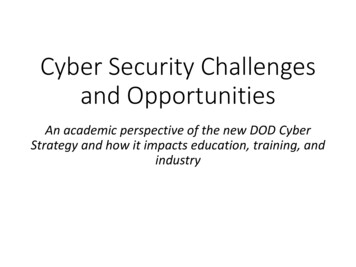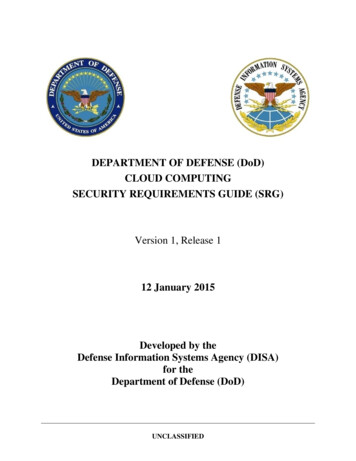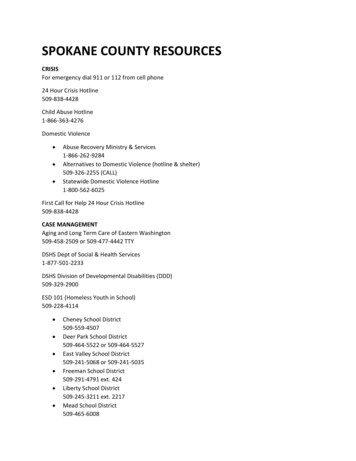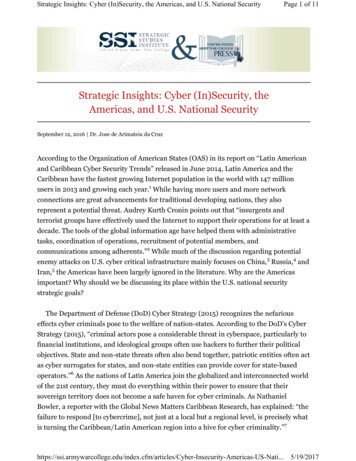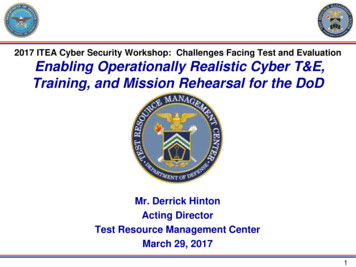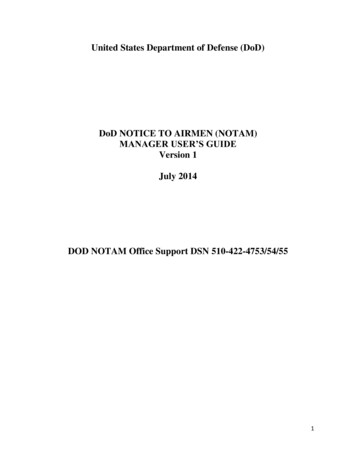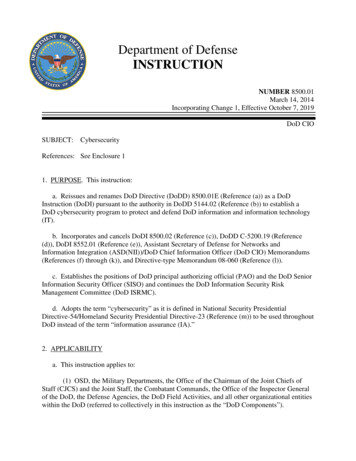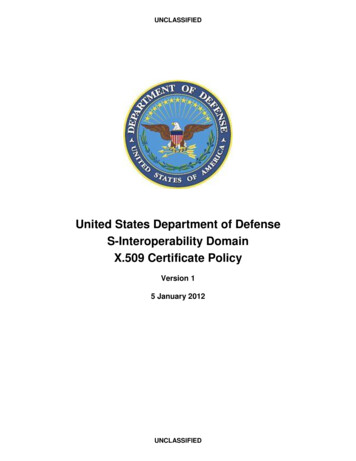
Transcription
UNCLASSIFIEDUnited States Department of DefenseS-Interoperability DomainX.509 Certificate PolicyVersion 15 January 2012UNCLASSIFIED
UNCLASSIFIEDTHIS PAGE INTENTIONALLY LEFT BLANKUNCLASSIFIED
UNCLASSIFIEDTABLE OF CONTENTS12Introduction . 1Publications and Repository Responsibilities . 52.1Repositories .52.2Publication of Certification Information.52.3Time or Frequency of Publication .52.4Access Controls on Repositories .53 Identification and Authentication . 63.1Naming .63.1.1Types of Names .63.1.2Need for Names to be Meaningful .63.1.3Anonymity or Pseudonymity of Subscribers .63.1.4Rules for Interpreting Various Name Forms .63.1.5Uniqueness of Names .63.1.6Recognition, Authentication and Role of Trademarks .63.2Initial Identity Validation .63.2.1Method to Prove Possession of Private Key .63.2.2Authentication of Organization Identity .63.2.3Authentication of Individual Identity .63.2.4Non-Verified Subscriber Information .63.2.5Validation of Authority .73.2.6Criteria for Interoperation .73.3Identification and Authentication for Re-Key Requests.73.4Identification and Authentication For Revocation Request .74 Certificate Life-Cycle Operational Requirements . 84.1Certificate Application.84.1.1Who Can Submit a Certificate Application .84.1.2Enrollment Process and Responsibilities .84.2Certificate Application Process .84.2.1Performing Identification and Authentication Functions .84.2.2Approval or Rejection of Certificate Applications .84.2.3Time to Process Certificate Applications .84.3Certificate Issuance .84.3.1CA Actions during Certificate Issuance .84.3.2Notification to Subscriber by the CA of Issuance of Certificate .84.4Certificate Acceptance .84.4.1Conduct Constituting Certificate Acceptance .84.4.2Publication of the Certificate by the CA .94.4.3Notification of Certificate Issuance by the CA to Other Entities .94.5Key Pair and Certificate Usage .94.5.1Subscriber Private Key and Certificate Usage .94.5.2Relying Party Public Key and Certificate Usage .94.6Certificate Renewal .94.7Certificate Re-Key .94.8Certificate Modification .94.9Certificate Revocation and Suspension .94.9.1Circumstances for Revocation .94.9.2Who Can Request a Revocation.94.9.3Procedure for Revocation Request .104.9.4Revocation Request Grace Period .104.9.5Time within Which CA Must Process the Revocation Request .104.9.6Revocation Checking Requirements for Relying Parties .104.9.7CRL Issuance Frequency .104.9.8Maximum Latency for CRLs .104.9.9On-line Revocation/Status Checking Availability .104.9.10 On-line Revocation Checking Requirements .10iUNCLASSIFIED
UNCLASSIFIED567894.9.11 Other Forms of Revocation Advertisements Available .114.9.12 Special Requirements Related to Key Compromise.114.9.13 Certificate Suspension and Restoration .114.10Certificate Status Services .114.11End of Subscription .114.12Key Escrow and Recovery .11Facility, Management, and Operational Controls . 125.1Physical Controls .125.2Procedural Controls.125.3Personnel Controls .125.4Audit Logging Requirements .125.5Records Archival .125.6Key Changeover .125.7Compromise and Disaster Recovery .125.7.1Incident and Compromise Handling Procedures .125.7.2Computing Resources, Software, and/or Data are Corrupted .125.7.3Entity Private Key Compromise Procedures .135.7.4Business Continuity Capabilities after a Disaster .135.8CA, RA, or TA Termination .13Technical Security Controls . 146.1Key Pair Generation and Installation .146.1.1Key Pair Generation .146.1.2Private Key Delivery to Subscriber .146.1.3Public Key Delivery to Certificate Issuer .146.1.4CA Public Key Delivery to Relying Parties .146.1.5Key Sizes .146.1.6Public Key Parameters Generation and Quality Checking .146.1.7Key Usage Purposes (as per X.509 v3 Key Usage Field) .146.2Private Key Protection and Cryptographic Module Engineering Controls .146.3Other Aspects of Key Pair Management .146.3.1Public Key Archival .146.3.2Certificate Operational Periods and Key Pair Usage Periods .146.4Activation Data .146.5Computer Security Controls .146.6Life Cycle Technical Controls .146.7Network Security Controls .156.8Time Stamping .15Certificate, CSP, and OCSP Profile . 167.1Certificate Profile .167.2CRL Profile .167.3OCSP Profile .16Compliance Audit and Other Assessments. 178.1Frequency and Circumstances of Assessment .178.2Identity/Qualifications of Assessor .178.3Assessor’s Relationship to Assessed Entity .178.4Topics Covered by Assessment.178.5Actions Taken as a Result of Deficiency .178.6Communication of Results .17Other Business and Legal Matters . 189.1Fees.189.2Financial Responsibility .189.3Confidentiality of Business Information .189.4Privacy Of Personal Information .189.5Intellectual Property Rights .189.6Representations and Warranties .189.7Disclaimers of Warranties .189.8Limitations of Liability .189.9Indemnities .18iiUNCLASSIFIED
UNCLASSIFIED9.10Term and Termination .189.10.1 Term .189.10.2 Termination .189.10.3 Effect of Termination and Survival .189.11Individual Notices and Communications With Participants .199.12Amendments.199.12.1 Procedure for Amendment .199.12.2 Notification Mechanism and Period .199.12.3 Circumstances under which OID Must be Changed .199.13Dispute Resolution Provisions .199.14Governing Law.199.15Compliance With Applicable Law .199.16Miscellaneous Provisions .199.17Other Provisions .19Appendix A References . 20Appendix B Acronyms and Abbreviations. 21Appendix C Glossary of Terms . 23iiiUNCLASSIFIED
UNCLASSIFIEDTHIS PAGE INTENTIONALLY LEFT BLANKivUNCLASSIFIED
UNCLASSIFIED1 INTRODUCTIONThis Certificate Policy (CP) identifies the operations of the Multi-Domain Public Key Infrastructure (PKI)created by the S-Interop Root Certification Authority (CA).The S-Interop PKI Domain is a hierarchical architecture, with the S-Interop Root CA at the top of thehierarchy. The S-Interop Root CA issues one-way cross-certificates to CAs (referred to as member CAs)that operate on National SECRET level networks to create the S-Interop Domain.The issuance of a cross-certificate by the S-Interop Root CA to an external PKI does not imply approval forestablishing connections between networks. It only facilitates trust of PKIs within networks which areapproved for connection by other processes.1.1OVERVIEWThe S-Interop CP outlines the policy for the operation of the S-Interop Root CA and the procedures for theapproval and issuance of cross-certificates to member CAs. This CP is modeled after the Internet X.509Public Key Infrastructure Certificate Policy and Certification Practices Framework [RFC 3647].Member CAs that are issued cross-certificates from the S-Interop Root CA operate under existing CPs andCertification Practice Statements (CPSs).1.1.1 Certificate PolicyThe S-Interop CP defines the policies asserted in cross-certificates issued by the S-Interop Root CA. Allcross-certificates issued by the S-Interop Root CA shall contain a mapping from an S-Interop CP ObjectIdentifier (OID) to one or more Policy OIDs supported by the member CA that may be used by a RelyingParty to determine the security and technical controls of the policy under which an end entity certificate wasissued.The S-Interop CP is based on the Committee on National Security Systems Instruction 1300 – Instruction forNational Security Systems Public Key Infrastructure X.509 Certificate Policy [NSS-PKI], and references[NSS-PKI] for many sections which have the same requirements. This CP provides specific requirements forthe S-Interop Multi-Domain PKI where it differs from [NSS-PKI]. Where a section says “See [NSS-PKI],”[NSS-PKI] requirements apply to the S-Interop Root CA. Otherwise, the content of this CP directs theoperations of the S-Interop Root CA.1.1.2 Relationship between the Certificate Policy and the Certification PracticeStatementThis S-Interop CP identifies the requirements for the operations of the S-Interop Root CA and the issuance ofcross-certificates to member CAs. The S-Interop Root CA CPS states how the S-Interop Root CA meetsthose requirements. Member CAs are issued cross-certificates from the S-Interop Root CA and areexpected to operate under existing CPs and CPSs.1.1.3 ScopeThis CP applies to the S-Interop Root CA and to the issuance of cross-certificates to member CAs operatingin the S-Interop PKI Domain.1.1.4 Interoperation with CAs Issuing Under Different PoliciesThe S-Interop Domain is defined by the set of CAs that have been issued one way cross-certificates by theS-Interop Root CA. The cross-certificate defines the policy mapping from an S-Interop CP OID to one ormore CP OIDs asserted by the member CA. The issuance of cross-certificates will be performed under thedirection of the DoD PKI Program Management Office (PMO).1UNCLASSIFIED
UNCLASSIFIED1.2DOCUMENT NAME AND IDENTIFICATIONThe official title of the CP is the United States Department of Defense S-Interoperability Domain X.509Certificate Policy.The S-Interop Domain CP defines Certificate Policies. Each Certificate Policy has an OID, to be asserted incross-certificate mappings to member CAs that comply with the stipulations related to that policy. The OIDsare registered under the id-infosec arc as:{joint-iso-ccitt(2) country(16) us(840) organization(1) gov(101) dod(2) infosec(1) eID:: {id-certificate-policy 32}ID:: {id-certificate-policy 33}ID:: {id-certificate-policy 34}The stipulations presented in this CP apply to all OIDs unless otherwise noted.This CP is the authoritative source for the definition and assignment of Policy OIDs for the S-Interop Domain.The S-Interop Root CA may include these OIDs in end entity certificates necessary for operation (to includeOnline Certificate Status Protocol (OCSP) delegated trust model certificates). The S-Interop Root CA shallconform to the requirements specified in [NSS-PKI] for issuing end entity certificates. The following providesthe comparability between S-Interop Domain and [NSS-PKI] eviceid-US-dod-S-InteropDeviceFor cross certificates:The id-US-dod-S-InteropDevice OID shall only be used in cross certificates which map to a member policyOID that is only for devices.The id-US-dod-S-InteropHardware and id-US-dod-S-InteropSoftware OIDs may be used for certificatesissued to people, roles or devices.1.3PKI PARTICIPANTSThe following sections introduce the entities that participate in the S-Interop Domain. Responsibilities,qualifications, and additional controls for individuals designated as holding a trusted role are described indetail in Section 5.2.1.3.1 Policy ManagementThe Policy Management Authority (PMA) for the S-Interop Domain is the Director, DoD PKI PMO. The PMAhas the following responsibilities: Approve this S-Interop CP; Approve the S-Interop Root CA CPS; and, Approve the issuance of cross-certificates from the S-Interop Root CA to member CAs.1.3.2 Certification AuthoritiesThe S-Interop Root CA is the trust anchor for the S-Interop Domain. The S-Interop Root CA is responsiblefor issuing and managing cross-certificates including the following:2UNCLASSIFIED
UNCLASSIFIED The cross-certificate manufacturing and issuance process; Publication of its own signing certificate and cross-certificates; Revocation of cross-certificates; Publication of CRLs; and, Ensuring that all aspects of the Root CA services, operations, and infrastructure related tocertificates issued under this CP are performed in accordance with the requirements,representations, and warranties of this CP.A member CA is a CA that has been issued a cross-certificate from the S-Interop Root CA. Member CAsissue certificates to subordinate CAs and end entities (e.g., people, devices).1.3.3 Registration AuthorityThe S-Interop Root CA does not use the services of Registration Authorities. Operations of the S-InteropRoot CA, including the issuance of cross-certificates, are performed by CA Operations staff.1.3.4 SubscriberA Subscriber is the entity whose name appears as the subject in a certificate. While CAs are technicallynamed in certificates, the term only refers to end entities and not certificate issuers. The S-Interop Root CAdoes not directly issue subscriber certificates. A subscriber in the S-Interop Domain is any end entity thathas been issued a certificate by a member CA that has been issued a cross-certificate by the S-Interop RootCA or is subordinate to such a CA.1.3.5 Relying PartyA Relying Party uses a Subscriber’s certificate to verify or establish one or more of the following: The identity and status of an individual, role, system or device; The integrity of a digitally signed message; The identity of the creator of a message; and, Confidential communications with the Subscriber.A Relying Party is the entity that relies on the validity of the binding of the Subscriber’s name to a public key.A Relying Party is responsible for deciding whether or how to check the validity of the certificate by checkingthe appropriate certificate status information. A Relying Party may use information in the certificate (such asCP OIDs) to determine the suitability of the certificate for a particular use.Relying Parties may base the reliance they choose to place on a certificate on factors such as the amountand type of inherent risk of an activity, the consequence of failure, and the use of risk mitigation controls.A Relying Party to the S-Interop Domain is defined as a party that has established direct trust in the SInterop Root CA and thus trusts all certificates issued by member CAs and their subordinate CAs. Partieswho directly trust a CA that is also cross certified but do not directly trust the S-Interop Root CA are notconsidered Relying Parties of the S-Interop Domain.1.3.6 Other ParticipantsThe S-Interop Root CA may require the services of other security, community, and application authorities,such as compliance auditors. These authorities, their services, and the mechanisms used to support theirservices shall be identified.1.4CERTIFICATE USAGEPKIs can support the following security services: confidentiality, integrity, authentication, and technical nonrepudiation. PKIs support the authentication, integrity, and technical non-repudiation security services3UNCLASSIFIED
UNCLASSIFIEDthrough digital signatures, and the confidentiality security service through encryption. These basic securityservices support the long-term integrity of application data, but by themselves may not provide a sufficientintegrity solution for all application circumstances.1.4.1 Appropriate Certificate UsesCertificates issued under this policy are used to determine the mapping from the member CA CP to the SInterop CP and are intended to be used to facilitate protection of information classified at SECRET or belowwithin SECRET networks or information systems.1.4.2 Prohibited Certificate UsesCertificates issued under this CP shall not be used other than to support transactions related to UnitedStates (U.S.) Government business.1.5POLICY ADMINISTRATION1.5.1 Organization Administering the DocumentThe PMA is responsible for all aspects of this CP.1.5.2 Contact PersonQuestions regarding this CP should be directed to:DOD PKI PROGRAM MANAGEMENT OFFICE9800 SAVAGE RD STE 6718FT GEORGE G MEADE MD 20755-67181.5.3 Person Determining CPS Suitability for the PolicyThe PMA shall affirm the suitability of the S-Interop Root CA CPS to this policy.1.5.4 CPS Approval ProceduresThe S-Interop Root CA shall be operated in conformance with the S-Interop Root CA CPS. This CPS shallbe conformant with the NSS Root CA CPS except for requirements related to the issuance of crosscertificates (Sections 1.1.4, 1.2, 1.3.1.1, 1.3.1.2 and 3.2.6), where it shall conform to the stipulations of thisCP.All member CAs shall operate in conformance with CPSs that have been approved as meeting therequirements of their associated CPs.1.5.5 WaiversSee [NSS-PKI].1.6DEFINITIONS AND ACRONYMSSee Appendices B and C.4UNCLASSIFIED
UNCLASSIFIED2 PUBLICATIONS AND REPOSITORY RESPONSIBILITIES2.1REPOSITORIESThe S-Interop Root CA and each cross-certified member CA shall maintain a repository that supports HTTPor LDAP to provide CA certificates and CRLs. Member CA repositories shall be operated such that expectedrelying parties have access to necessary data at least 95% of the time.2.2PUBLICATION OF CERTIFICATION INFORMATIONThe S-Interop Root CA and each cross-certified member CA shall provide an on-line repository that isavailable to Subscribers and Relying Parties and that contains: The CA’s signing certificate; Any Subordinate CA signing certificates; The most recent CRL for the CA and any Subordinate CAs; and, The CP that governs the operations of the CA.In addition, the S-Interop Root CA shall provide the following:2.3 This S-Interop CP; All cross-certificates issued by the S-Interop Root CA; and, A list of entities that have been issued cross-certificates, along with information about obtaininginformation from the on-line repositories for those member CAs.TIME OR FREQUENCY OF PUBLICATIONS-Interpop Root CA requirements for
The official title of the CP is the United States Department of Defense S-Interoperability Domain X.509 Certificate Policy. The S-Interop Domain CP defines Certificate Policies. Each Certificate Policy has an OID, to be asserted in cross-certificate mappings to member CAs that comply with the stipulations related to that policy. The OIDs
